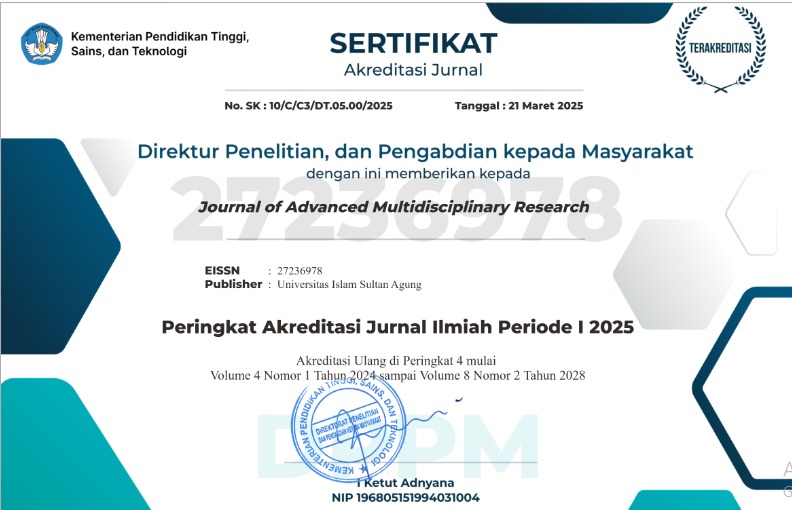The Correlation between Gross Motor Function Classification System and Spasticity in Children with Cerebral Palsy
Abstract
Gross Motor Function Classification System (GMFCS) was used as a criterion to classify motor function in children with cerebral palsy. Spasticity is an increase in muscle resistance to passive stretching, which is an involuntary muscle activity associated with upper motor neuron paralysis that occurs in CP children so that it interferes with their activities. The purpose of this study was to determine the relationship between GMFCS and the level of spasticity assessed by the Ashworth scale in children with cerebral palsy. The analytical research method was observational with a cross sectional approach, the independent variable was assessed on the functional scale using the GMFCS and the dependent variable was assessed for spasticity using the Ashworth scale. The research sample was CP children at YPAC Semarang city. The results of this study are that the highest GMFCS level in children with cerebral palsy at SLB YPAC Semarang City is level III and IV as much as 25.0% while the assessment of spasticity using the ashworth scale obtained ashworth level 3 as much as 58.3% while the results of the calculation of the non-parametric Spearman correlation test were obtained. p value = 0.000 (p < 0.05) with a value of r = 0.837. Therefore, it can be concluded that there is a positive correlation between GMFCS and the level of spasticity assessed using the Ashworth scale in children with cerebral palsy.
Keywords
Full Text:
PDFReferences
Alriksson-Schmidt, A., & Hägglund, G. (2016). Pain in Children and Adolescents with Cerebral Palsy: A Population-Based Registry Study. Acta Paediatrica, International Journal of Paediatrics 105(6): 665–70.
Ansari, N. N., Soofia Naghdi, Hoda Moammeri, & Shohreh Jalaie. (2006). Ashworth Scales Are Unreliable for the Assessment of Muscle Spasticity. Physiotherapy Theory and Practice 22(3): 119–25.
Chen, Chia Ling. (2011). Developmental Profiles and Temperament Patterns in Children with Spastic Cerebral Palsy: Relationships with Subtypes and Severity. Journal of the Formosan Medical Association 110(8): 527–36. https://dx.doi.org/10.1016/S0929-6646(11)60079-X.
Dehno, N. S., Shohreh Noorizadeh Dehkordi, Mehdi Dadgoo, & Masoud Salehi. (2012). Association between Spasticity and the Level of Motor Function with Quality of Life in Community Dwelling Iranian Young Adults with Spastic Cerebral Palsy. Medical Journal of the Islamic Republic of Iran 26(4): 150–56.
Eunson, P. (2012). Aetiology and Epidemiology of Cerebral Palsy. Paediatrics and Child Health (United Kingdom) 22(9): 361–66. https://dx.doi.org/10.1016/j.paed.2012.05.008.
Fosdahl, Merete Aarsland, Reidun Jahnsen, Are Hugo Pripp, and Inger Holm. (2020). Change in Popliteal Angle and Hamstrings Spasticity during Childhood in Ambulant Children with Spastic Bilateral Cerebral Palsy. A Register-Based Cohort Study.†BMC Pediatrics 20(1): 1–9.
Gorter, Jan Willem, Olaf Verschuren, Laura Van Riel, & Marjolijn Ketelaar. (2009). The Relationship between Spasticity in Young Children (18 Months of Age) with Cerebral Palsy and Their Gross Motor Function Development. BMC Musculoskeletal Disorders 10(1): 1–9.
Katusic, Ana, & Sonja Alimovic. (2013). The Relationship between Spasticity and Gross Motor Capability in Nonambulatory Children with Spastic Cerebral Palsy. International Journal of Rehabilitation Research 36(3): 205–10.
Mutlu, Akmer, Ayse Livanelioglu, and Mintaze Kerem Gunel. (2008). Reliability of Ashworth and Modified Ashworth Scales in Children with Spastic Cerebral Palsy. BMC Musculoskeletal Disorders 9: 1–8.
Palisano, R., Rosenbaum, P., Bartlett, D., Livingston, M., Walter, S., Russell, D., … Galuppi, B. (2007). Gross Motor Function Classification System Expanded and Revised. Dev Med Child Neurol, 39, 214–223. https://doi.org/10.1111/j.1469-8749.2.â€
Reilly, M., Kayley Liuzzo, & Allison B. Blackmer. (2020). Pharmacological Management of Spasticity in Children With Cerebral Palsy. Journal of Pediatric Health Care 34(5): 495–509.
Rethlefsen, S. A. (2017). Prevalence of Specific Gait Abnormalities in Children with Cerebral Palsy Revisited: Influence of Age, Prior Surgery, and Gross Motor Function Classification System Level.†Developmental Medicine and Child Neurology 59(1): 79–88.
Ross, S. A., & Jack R. Engsberg. (2007). Relationships Between Spasticity, Strength, Gait, and the GMFM-66 in Persons With Spastic Diplegia Cerebral Palsy. Archives of Physical Medicine and Rehabilitation 88(9): 1114–20.
Shevell, M. I., Lynn Dagenais, & Nicholas Hall. (2009). Comorbidities in Cerebral Palsy and Their Relationship to Neurologic Subtype and GMFCS Level. Neurology 72(24): 2090–96.
DOI: https://dx.doi.org/10.30659/jamr.2.2.70-77
Refbacks
- There are currently no refbacks.
Copyright (c) 2021 Journal of Advanced Multidisciplinary Research
Journal of Advanced Multidisciplinary Research (JAMR) is published by Research and Community Service Department (LPPM) Universitas Islam Sultan Agung Semarang, Indonesia.
Address: Jl. Kaligawe Raya Km. 4 Semarang, Indonesia.





